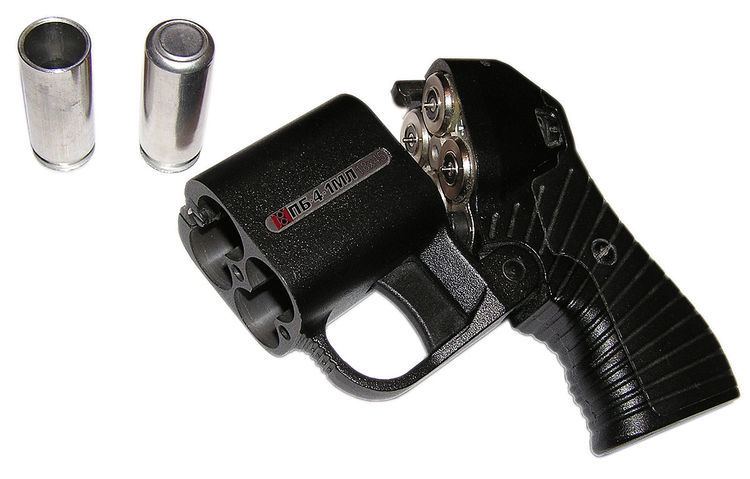Designed 1997-1999 Length 1.77" (45 mm) | Weight 0.4 kg Cartridge 18×45 mm | |
 | ||
OSA (Russian: ОСА, "wasp") is a family of Russian non-lethal pistols that can be also used as flare gun, flashbang gun or starting pistol. The system consists of the gun (2-4 cartridges, laser target pointer, electronic ignition capsule), and various ammunition types.
Contents
OSA was developed in the 1990s by engineer-constructor and weapon designer G.A. Bideev (Г.А. Бидеев). It was designed and is manufactured by the state-owned organizations Federal Center for Research and Manufacturing and The Institute for Science and Research in the Applied Chemistry. The pistol is available in the civilian market.
Design details
The PB-4 is a four-barreled break-action gun. It has two horizontal "8"-shaped chambers in its aluminum chamber block, each housing two rounds. There is no need for a separate chamber for each round, because the gas pressure is contained by the cartridges' thick cylindrical case (the external case diameter is 18mm, while the bullet caliber is 15.3mm). This design aims to prevent the gun from operating properly if the round is unlawfully modified to increase its power. The cartridge case also performs the function of the barrel, with the bullet positioned deep inside and accelerating within the case. The front end of the case is level with the front end of the chamber block when in firing position. There is a four-fingered extractor in the central channel of the chamber block; the cartridge cases are rimless and have an extractor groove. The extractor keeps cases from falling forward outside of the chamber block. When the action is opened, cases are extracted backwards for manual reloading. The trigger and trigger guard are fixed to lower side of the chamber block.
The chamber block is locked to the handle block, which contains the locking surface, firing button (pushed by the trigger when the chamber block is locked), pistol grip, battery and electronics. The cartridge primers are ignited electrically, so there are four circular contact plates on the locking surface (contacting the case bottom) and four contact pins in the center of each plate (contacting the primer). On the trigger pull an impulse is generated. The electronic firing mechanism is able to send firing impulses in sequence to the chambers from 1 to 4 and to skip chambers with malfunctioning rounds to avoid misfires. The weapon is only capable of firing one round at a time. There are different models of PB-4; in some, the firing mechanism is fed by a battery, on others by a piezoelectric igniter similar to those used by kitchen gas lighters.
There is a simple sight assembly atop the chamber block – a semi-cylindrical groove along it, and a white forward post at the front of the groove. Some variants of PB-4 have a built-in laser sight with a laser window in the center of the "locking surface", and the beam following the central extractor channel of the chamber block. The laser switch on the left side of the handle block is operated by the thumb, and the laser is fed by a battery inside the pistol grip. There are no safety switches – the locked and loaded weapon is always ready to fire (provided the battery is not discharged, for the models which use a battery).
The OSA Handgun M09 has been marketed in The Americas via Defenzia, LLC in the USA and Defenzia, LTDA in Brazil. Defenzia plans on assembling and manufacturing the pistols in Brazil and subsequently in the USA beginning in 2016 under the Brand Defenzia.
OSA and Defenzia have entered into this joint agreement in 2014. In 2016 both companies plan on launching the civilian "M11" version of the weapon in the USA. This new less-lethal weapon for the civilian market will come in 50 Caliber and have the same capabilities as the law-enforcement weapon, and awaits BATF approval.
Non-lethality
A person shot from about 1 meter with an 18x45T OSA pistol to the temporal region of the head suffered a penetrative injury, with the bullet traversing most of the brain, reducing the victim to a vegetative state.
Variants
Legal status
Cartridges
A set of «OSA» consists of several types of cartridges, intended for self-defense (and traumatic light-and-sound) and illumination.
The pistol launcher itself generates an electric pulse to ignite the gunpowder charge.
